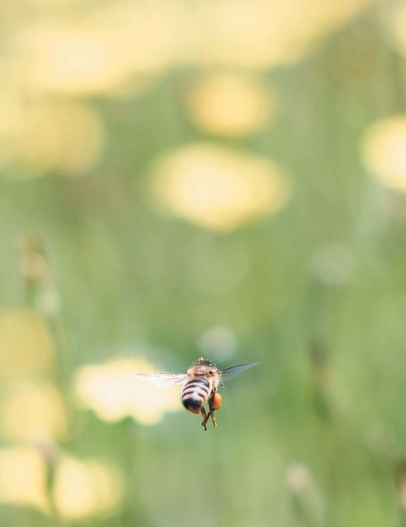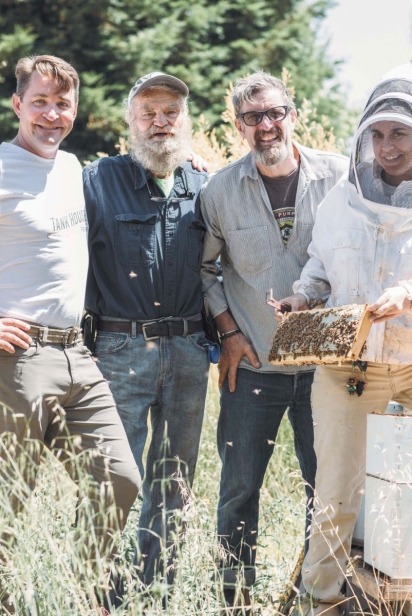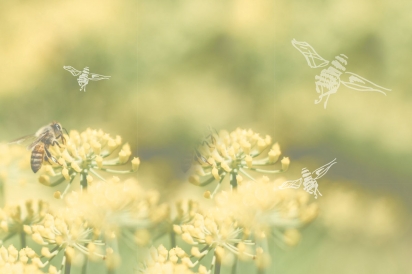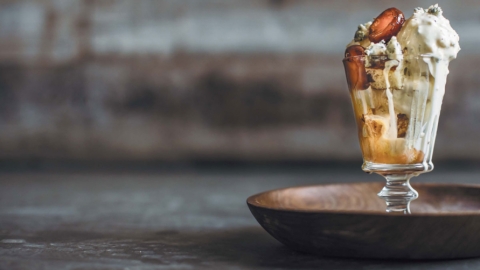Let the Weeds Be(e)
HOW WE CAN HELP SAVE THE BEES
UNLIKELY COMRADES IN ARMS, 38-YEAR-OLD CHRISTOPHER “LANDY” LANDERCASPER, 80-YEAR-OLD SPENCER MARSHALL, 58-YEAR-OLD ROB KELLER AND 38-YEAR-OLD AMBER HANDY SHARE A PASSION THAT BINDS THEM TOGETHER AND OFTEN FINDS THEM PERFORMING “HIVE DIVES” TOGETHER: HONEY BEES.
With more than 120 years of collective experience farming honey bees, Landy, Spencer, Rob (profiled in Edible Marin & Wine Country’s Spring 2015 issue) and Amanda are well versed in the myriad challenges facing the tiny creatures that are essential to the world’s food supply, in addition to producing sweet, delicious honey. Much has been written, including in this magazine, about these grave dangers ranging from Varroa mites to chemical poisoning to overcrowding and loss of habitat and forage. So much, in fact, that it may leave us feeling like the battle for the bees is one that can’t be won.
It was Landy, director of agriculture for Sonoma’s Best Hospitality Group, who initially convened this esteemed group of beekeepers back in 2020 for the purpose of sharing best practices for keeping bees in the Sonoma and Napa Valleys. The group has met every few months since, and I was fortunate to join them this past July to share a fabulous lunch prepared by Folktable Executive Chef Casey Thompson that included several dishes that highlighted honey produced just a short walk from our table. I was struck by the positive tone of the message coming from these bee warriors—they want to spread the word about what CAN be done to help bees in our area. And not just by the experts; there are simple but significant actions that all of us can take: Let the weeds be! Flowering weeds can provide a lot of food for bees. Dandelions and wild fennel are great examples. Plant more forage, and make sure that it is “clean” and has a “high recharge rate”—organically grown seeds and plant starts do not already contain chemicals harmful to bees and some plants like lavender and salvia have a faster pollen refill rate. Join local groups like Master Gardeners or just seek them out for advice on what to plant for bees.
Ask your relevant city and county officials and the California Department of Transportation to not use chemical herbicides on government-owned land but to leave weeds to flower. Choose carefully when you purchase honey—commodity honey found on most large chain grocery shelves could be cut with rice syrup, and buying locally produced honey has flavor and health benefits, in addition to contributing to the local economy.
Gibson Thomas is the founder of Edible Marin & Wine Country and a keeper of bees in her own backyard in Marin County.
THERE ARE ACTIONS THAT ALL OF US CAN TAKE TO HELP SAVE THE BEES!
Let the weeds be! Flowering weeds can provide a lot of food for bees. Dandelions and wild fennel are great examples.
Plant more forage, and make sure that it is “clean” and has a “high recharge rate”—organically grown seeds and plant starts do not already contain chemicals harmful to bees and some plants like lavender and salvia have a faster pollen refill rate.
Join local groups like Master Gardeners or just seek them out for advice on what to plant for bees.








